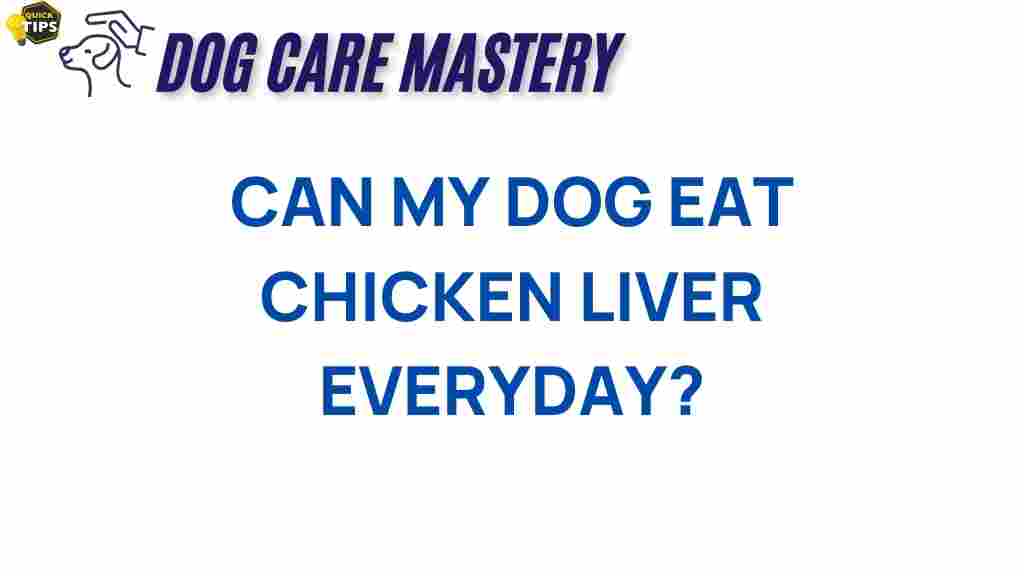Is Feeding Your Dog Chicken Liver Daily a Healthy Choice for Their Dog Diet?
As a responsible pet owner, you want the best for your furry friend, and that includes choosing the right diet. One common question that arises is whether feeding your dog chicken liver daily is a healthy choice. Chicken liver is packed with nutrients, but moderation is key. In this article, we’ll explore the nutritional benefits of chicken liver, how to incorporate it into your dog’s diet, and what to watch out for to ensure your pup remains healthy.
Understanding Your Dog’s Nutritional Needs
Before diving into the specifics of chicken liver, it’s essential to understand your dog’s overall nutritional needs. A balanced dog diet should include:
- Proteins: Essential for growth, maintenance, and energy.
- Fats: Important for brain health and energy levels.
- Carbohydrates: A source of energy and fiber.
- Vitamins and Minerals: Crucial for immune function, bone health, and overall well-being.
Chicken liver can be a nutritious addition to your dog’s diet, but it’s important to balance it with other food sources to meet your dog’s complete nutritional requirements.
The Nutritional Benefits of Chicken Liver
Chicken liver is rich in various nutrients that can significantly contribute to your dog’s health:
- High in Protein: Chicken liver contains a high level of protein, which is essential for muscle development and repair.
- Loaded with Vitamins: It is particularly high in vitamins A, B12, and folate, which are vital for a strong immune system and overall health.
- Rich in Minerals: Chicken liver provides important minerals such as iron, copper, and zinc, which help in red blood cell production and overall vitality.
- Omega-3 Fatty Acids: These fatty acids support skin and coat health.
These benefits make chicken liver a tempting option for enhancing your dog’s dog diet.
How to Incorporate Chicken Liver into Your Dog’s Diet
Feeding your dog chicken liver should be done thoughtfully. Here’s a step-by-step guide to safely incorporate chicken liver into your dog’s diet:
Step 1: Consult Your Veterinarian
Before making any significant changes to your dog’s dog diet, it’s wise to consult your veterinarian. They can provide personalized advice based on your dog’s age, weight, and health status.
Step 2: Choose Fresh, High-Quality Liver
Opt for organic, free-range chicken liver when possible. This ensures that the liver is free from harmful chemicals and provides the highest quality nutrients.
Step 3: Prepare the Liver Properly
Chicken liver can be served cooked or raw, but cooking it can help eliminate potential bacteria. If you choose to cook it:
- **Boil or sauté** it in a pan without oil or seasoning.
- **Avoid frying** or adding spices, as these can be harmful to dogs.
Step 4: Monitor Portion Sizes
Chicken liver should only make up a small portion of your dog’s overall diet. A good rule of thumb is to limit liver to:
- Small dogs: 1/2 ounce per day.
- Medium dogs: 1 ounce per day.
- Large dogs: 2 ounces per day.
Excessive consumption can lead to vitamin A toxicity, which can cause serious health issues.
Step 5: Mix with Other Foods
To provide a balanced dog diet, consider mixing chicken liver with other protein sources like chicken, beef, or fish, along with vegetables and grains.
Potential Risks of Feeding Chicken Liver Daily
While chicken liver has many benefits, it’s essential to be aware of potential risks:
- Vitamin A Toxicity: As mentioned earlier, overconsumption of liver can lead to an excess of vitamin A, resulting in symptoms such as lethargy, joint pain, and loss of appetite.
- High Cholesterol: Chicken liver is high in cholesterol, which may not be suitable for dogs with certain health conditions.
- Bacterial Contamination: Raw liver can harbor bacteria like Salmonella. Ensure proper handling and cooking to reduce risks.
Troubleshooting Common Issues
If you notice any adverse reactions after introducing chicken liver into your dog’s dog diet, here are some troubleshooting tips:
- Monitor for Allergies: If your dog shows signs of an allergic reaction, such as itchiness or gastrointestinal upset, discontinue feeding liver and consult your vet.
- Watch for Digestive Issues: Introduce chicken liver gradually into your dog’s diet to avoid diarrhea or vomiting.
- Adjust Portion Sizes: If your dog is gaining weight or showing signs of discomfort, reduce the amount of liver you’re feeding.
Alternative Protein Sources
If chicken liver does not suit your dog, consider other protein sources to complement your dog’s dog diet:
- Beef: Rich in protein and iron.
- Fish: Provides omega-3 fatty acids beneficial for coat health.
- Eggs: A complete protein source packed with nutrients.
Switching up protein sources can keep your dog’s diet varied and enjoyable.
Conclusion
Feeding your dog chicken liver daily can be a healthy choice when done in moderation and as part of a balanced dog diet. The nutritional benefits of chicken liver are impressive, but it’s crucial to pay attention to portion sizes and the overall balance of your dog’s meals. Always consult your veterinarian before making dietary changes and monitor your dog for any adverse reactions.
With the right approach, chicken liver can be a delicious and nutritious addition to your dog’s diet, supporting their health and happiness. For more tips on dog nutrition, check out this comprehensive guide. Remember, a well-fed dog is a happy dog!
For further reading on dog diet choices, visit this external resource for more information.
This article is in the category Nutrition and created by dogcaremastery Team
